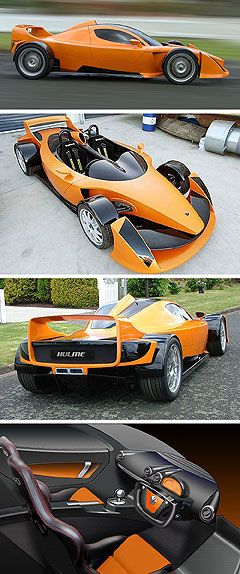Kiwi supercar set to fly
BY DAVID HASSALL | 11th Jun 2009

Named after the country’s only world Formula 1 champion, Denny Hulme, who died of a heart attack while driving a BMW in the 1992 Bathurst 1000, the new supercar pulls together the combined talents of a large number of talented Kiwis with experience in world motor sport and yachting.
The open-topped and windowless speedster-style road/track supercar is powered by a 600 horsepower (447kW) Corvette LS7 V8 engine and has been provisionally priced at €280,000 ($A487,000).
It weighs only 980kg and has a projected top speed of more than 330km/h, although the maximum achieved in testing to date has not yet exceeded 248km/h.
Although seen at various NZ race circuits in recent months, the prototype was formally unveiled in Auckland the weekend before last and driven over the city’s long harbour bridge by its instigator, former yacht manufacturer and car enthusiast James ‘Jock’ Freemantle.
The metaphor of last week’s bridge crossing was none too subtle, representing another hurdle overcome by the Hulme supercar.
Mr Freemantle told GoAuto this week the next hurdle for his ambitious program was a public offering designed to raise between $NZ2 million and $NZ7.5 million ($A1.6m and $A5.9m).
He said two more variants were being developed – the Hulme F1, based on the original closed coupe seen as a full-size concept model a few years ago, and the Hulme Spyder.

He said it would use the same chassis as the CanAm but have a retracting roof, different front and rear wings and a redesigned rear end because the windscreen affected the engine air intake.
However, while the CanAm will be Chev-powered, both the F1 and Spyder will have more exotic engines. Interestingly, a former BMW designer is involved in the project and BMW NZ is listed as a supplier on the company’s website. The concept car was designed to take the engine from the M5.
“We are talking to various engine manufacturers around the world, including two who manufacture F1 engines, about becoming our supplier for the rest of our range,” Mr Freemantle said.
He said he had considered offering a supercharged Chevy engine in the CanAm, which would be a real driver’s car with no aids such as ABS or ESC. The F1 and Spyder, on the other hand, would have a full suite of Bosch-supplied electronic driver aids.
“We are not taking orders until we have a completed road-ready EU-certified car to demonstrate, although we do have a large number of interested purchasers who will be notified first when we are ready to accept orders,” said Mr Freemantle. One potential buyer apparently owns 41 supercars already.
The 68-year-old Freemantle left his native Scotland in 1965 after training as an engineer with Rolls-Royce. He rode a motor scooter around the globe to Australia, worked for a couple of years in Melbourne, met a Kiwi girl and then emigrated to the Land of the Long White Cloud and married.
He began the Hulme project seven years ago and in that time numerous other supercars have sprouted around the globe.
He remains confident that the Kiwi “can do” spirit will prevail once the first production model hits the road, probably towards the end of next year.
Mr Freemantle said two more pre-development cars would be built once funding was in place, with the first 10 production cars set to be delivered in 2010-2011. After that, annual production has been set at 25-30 cars.
The model name and open-top design reflects legendary US CanAm sportscar series won by Denny Hulme in 1968 and 1970. The prototype is painted in the famous orange colour of the thunderous McLaren CanAm race cars.
And, like the CanAm racers, the Hulme supercar is powered by a Chevrolet alloy V8 – in this case, tuned by race guru John Nicholson, another Kiwi who prepared the Cosworth engines that powered Emerson Fittipaldi and James Hunt to world F1 titles with McLaren in the 1970s.
Hulme lists the longitudinally-mounted 7.0-litre V8 as producing 447kW of power and 600Nm of torque, whereas the same engine in the HSV W427 produces 373kW and 640Nm. It drives through a Cima six-speed sequential gearbox.
First-time car designer Tony Parker is responsible for the Hulme supercar. He has been drawing cars since childhood and studied at the Royal College of Art in London with some of the automotive world’s styling giants – Murat Gunak (Mercedes-Benz and VW), Walter de’Silva (Alfa, Seat, VW and now Audi) and Moray Callum (Ford, Mazda).
Mr Parker’s career, however, went in a different direction and he is now a professor in industrial design at Massey University in Wellington, where he has taught for 23 years.
He produced about 100 sketches before Mr Freemantle jumped on one with the innovative semi-open-wheeled look that now invites comparisons with the Caparo T1.
In the background on the design side is Charles (Chuck) Pelly, an American who founded DesignworksUSA in a Malibu garage in 1972, had BMW as a client from 1986 and then sold the company to the Germans in 1995. He remained there until his recent retirement.
The Hulme CanAm’s largely carbon-fibre chassis and body – which is 4712mm long, 1958mm wide and 1095mm high – were produced by Wayne Smith, drawing on experience from two victorious America’s Cup campaigns.
It rides on a 2830mm wheelbase, has double-wishbone race suspension all-round, 19-inch front and 20-inch rear centre-lock wheels with Pirelli tyres and six-piston AP Racing brakes.
Hulme Supercars Ltd also boasts the involvement of racecar builder Bruce Turnbull, compliance experts Ron and Mike Brown, former Morgan assistant managing director Mark Aston and motor sport identity Inky Tulloch.
Like the Kiwi itself, the Hulme team may not be able to fly, but it can certainly punch above its weight and, like all New Zealanders, they are not afraid to take on the world. So don’t bet against these guys succeeding against the odds.